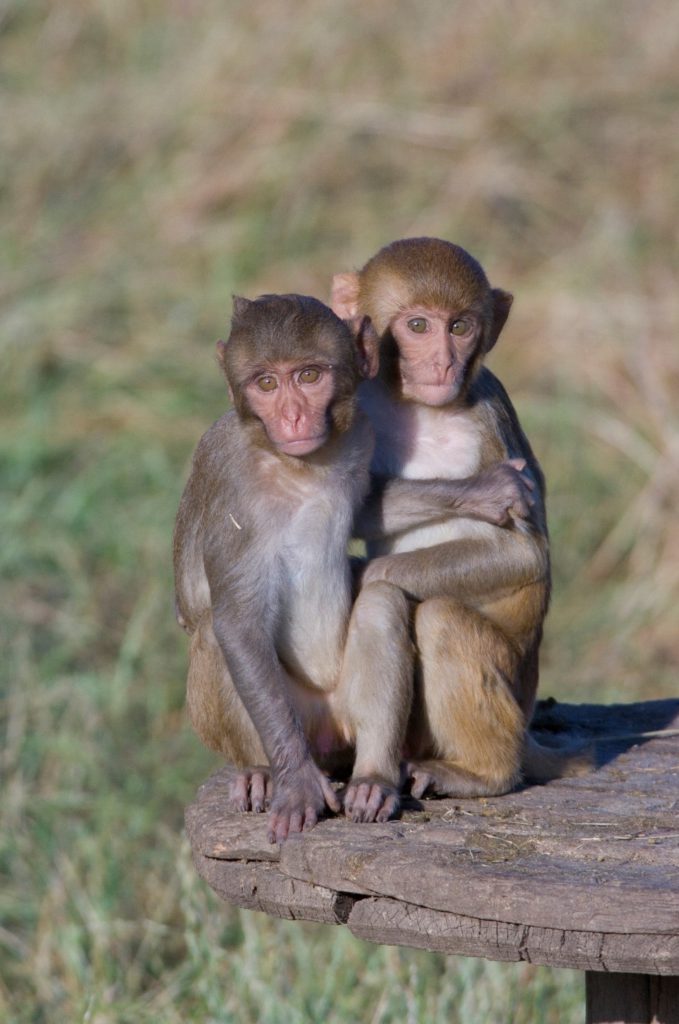
ASP Primate Welfare Award Winners (2023): The importance of social housing for primates in research
For this quarter of Hot Topics in primate welfare, we are featuring the work of the two winners of the ASP Primate Welfare Award from the 45th annual meeting in Reno, Nevada: Dr. Natalie Castell and Dr. Andrew Haertel.
Dr. Natalie Castell
Dr. Natalie Castell, a postdoctoral fellow at Johns Hopkins School of Medicine, won the award for her presentation “The Significance of Social Housing for Macaques in Infectious Disease Research”. This research focuses on the immunological differences between pigtail macaques housed socially versus singly and how these changes impact the pathogenesis of SIV infection. This work demonstrates that social context is an important consideration in research models, and that improving the welfare of laboratory primates also improves their translatability to human patients. To learn more about this project, watch a video presentation narrated by Dr. Castell.


Dr. Andrew Haertel
Dr. Andrew Haertel is an Associate Professor at the Oregon National Primate Research Center, where he serves as the Colony Hospital Veterinarian. He won the award for his presentation titled “Temporarily Paired Rhesus Macaques in a Research Primate Hospital Setting”. For this retrospective study, he reviewed the medical records of rhesus macaques that were separated from their social groups for wound care in the hospital and were housed either singly or paired with a compatible partner. He assessed healing times and the risk of hospital-acquired diarrhea in the unpaired versus paired rhesus monkeys and found that the median healing time between paired and unpaired monkeys was the same and the relative risk of hospital-acquired diarrhea was not significant in paired rhesus monkeys. Check out our interview with Dr. Haertel below for details about this project.

Interview with Dr. Andrew Haertel
What motivated you to do this study?
I was motivated to study our new pairings in the hospital because of the outstanding work that went into making these pairings happen. Years ago, our behavioral services unit identified the hospital as a potential space to improve on social housing, and, in 2018, the leaders of the behavior unit at our institution got the wheels moving to replace our single housing in the hospital with housing that can be converted to pair housing. As the head veterinarian in the hospital, I wanted to quantitatively document and evaluate this major change. My previous experience and training had taught me to isolate the ill animals in single housing to prevent disease spread. However, there is a growing body of evidence surrounding social buffering theory, which would support the idea that social housing in the hospital would benefit the monkeys and balance out or negate expenses to their medical care. So, we monitored the changes and accumulated data for several years to conduct a formal evaluation.

What are the main findings of your study? What do these findings tell us about the health and welfare benefits of pairing rhesus macaques during hospital stays?
Pairing unfamiliar monkeys for a short hospital stay has been a concern for veterinarians, as companions from different social groups can introduce a few risk factors that are thought to decrease the quality of medical care provided. Monkey companions could disrupt bandages, pick out sutures, or spread pathogens. The objective of our study was to check if the quality of medical care was actually affected by the new pairings. We found treatment times for pair housed monkeys in the hospital were not significantly different than those who were isolated in single housing. As such, we felt confident that we could offer companionship to monkeys and without risking or delaying their return to their home social group following treatment. Additionally, hospital-acquired diarrhea did not increase. This measure suggests that gastrointestinal pathogens are not spreading at any rate that compromises clinical care. These findings drive additional questions; for example, we are wondering if perhaps the social companionship of a partner offers a boost for the immune system, increases body healing, and buffers the transmission of pathogens.
You limited your analyses to include only digit and tail trauma cases. Would you expect the same or different results for other types of cases/reasons for hospitalization (diarrhea, musculoskeletal, respiratory, etc.)?
I definitely suspect that pair housing in the hospital would decrease treatment times and hospital-acquired diarrhea for more serious trauma, musculoskeletal, respiratory, and other health problems. I also think pair housing (and the potential social buffering effects) may decrease diarrhea treatment times for monkeys that have to be separated from their social group because of diarrhea problems. An important thing to note is that many diseases and injuries affecting monkeys appear on a wide spectrum of severity, and this variability inherently affects the treatment and hospitalization times. This can make study design and analysis difficult. For example, rating scales are often instituted to categorize the wide spectrum of clinical presentations into bins that can be analyzed with statistics, but, more often than not, clinicians do not agree on the categories. The potential impact of the study might be diminished to which categories fit rather than the actual findings, and the next scientist might use different categories, which make comparisons challenging. For these reasons, I knew we would need a narrow case definition on which clinicians could agree and that would stand up to scrutiny. Our digit and tail trauma cases have varied presentations of severity, but the treatment and resolution of these cases are largely the same. A few incidents can delay hospital stays for our digit/tail traumas, mainly suture picking, wound infection, or developing hospital-acquired diarrhea. These are all factors that we could measure indirectly via treatment time, and we hypothesize would improve from social housing.
What is the process for determining which patients get paired together? How is the compatibility of rhesus patients assessed? What else should be considered when deciding if patients would benefit from pairing during hospital stays?
We focused on pairing younger animals. Macaques can experience distress, sleep disruption, and even immune suppression as a result of social separation, and infants and juveniles may be most impacted by separation because they are still developing. Pairing young animals is also relatively safe compared to adult macaques since they are usually compatible. Infant and juvenile rhesus macaques can be paired with a very short and quick introduction and verification of compatibility. We also consider pairing adult macaques when they are expected to be housed in the hospital for long periods of time or if they can be paired with someone from their social group. Our behavior services unit coordinates most of the pairings. Their staff devote time each day to checking on monkey patients in the hospital to evaluate those that will benefit from pairing. Often, infants and juveniles can be paired on the day they enter the hospital due to the constant attention of behavior specialists to the population entering and exiting the hospital.
Are there individuals that might benefit more from pair housing during a hospital setting than others (e.g., based on age, sex, temperament, previous social history, etc.)?
I can drive home this message here: pairing the younger juvenile and older infant macaques is relatively easy and they benefit the most from having a companion. Pairing also seems to benefit our shy monkeys in the hospital so they are more likely to engage with clinicians. Shy monkeys with a partner might be bolder than when single-housed and will come forward and allow clinicians to monitor their health more closely.
How long do rhesus macaques need to be paired with a compatible partner to gain health and welfare benefits?
Benefits to psychological well-being should be immediate with compatible pairing, since rhesus are a social species. The physical health benefits are harder to detect, but every so often, we can see an immediate improvement in the attitude of monkeys who simply felt better after receiving a companion. Our dedicated staff try to make sure our juvenile and weanling monkeys are paired any time they will be in the hospital overnight. Hopefully, in the future, we can use a larger sample size that will allow us to examine how long monkeys need to be paired to gain specific health benefits.
What would the procedure be if one member of a pair heals before the other?
Each monkey in the hospital was separated from its social group because treating them in a social group was not possible. Once that monkey is healed, I think re-uniting that monkey with their troop is more important than maintaining a temporary pair in the hospital. Where does that leave the monkey who is left behind in the hospital then? If we can coordinate the return of both monkeys home on the same day, we would prefer that obvious route. If that option is not available, we are usually able to find a new partner for the monkey still in the hospital, sometimes the same day. Most of our juvenile- and weanling-age macaques are paired again immediately with a new compatible partner. There might be other monkeys in the hospital without a partner, or we can form triplet pairings for our younger monkeys.
What are the barriers or challenges of pair housing in the hospital setting? Are there ways these can be overcome?
Sometimes, we will run out of space in the hospital for pairing animals. In these cases, we may transfer monkeys around hospital to coordinate a pairing of two compatible animals. Fortunately, there is room to expand the amount housing that allows for pairing in our hospital, and, as we begin to accumulate data showing the positive results of pairing, we have plans for alterations to the current caging that will allow more pairing.
We also have to overcome the challenge of getting treatments to the right monkey within a pair. When we have one partner who tends to steal the other’s medication treats, we can try distracting the partner with treats, using positive reinforcement training to condition compliance, or partition the pair while they eat their medications. We spend a lot of time trying to flavor treats to mask any bitter-tasting medications and tracking each monkey’s favorite treats on a whiteboard as we determine what works. Once we identify a monkey’s beloved food, their partners tend to have less time to attempt to steal medication treats. We also use protected-contact dividers, panels that allow contact like grooming but still keep the animals in separate areas. These dividers can decrease medication thievery, bandage tampering, and allow for a safer and more gradual introduction between adults.
What prospective research are you planning to conduct to further investigate the health and welfare benefits of pairing rhesus macaques during hospital stays?
We are planning two further investigations. First, we have focused on diarrhea pathogen transmission during temporary pairings in the hospital, because, if one macaque has a pathogen, there is a big concern that that might lead to decisions to isolate that macaque. We are using a multiplex PCR panel test of diarrhea pathogens that will allow us to determine what bugs might be getting passed between paired monkeys. We would like to test the hypothesis that the social buffering effects of pairing would prevent pathogens from colonizing and infecting new partners. Second, we assume that monkey psychosocial well-being is enhanced by the pairing, but don’t have data to demonstrate that. To tackle this assumption, we are planning to measure behavioral indicators of stress in single and pair housed macaques in the hospital.